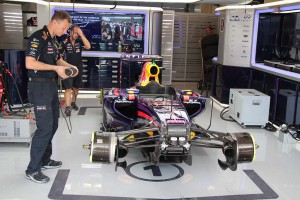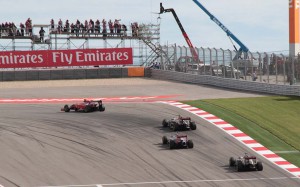
Formula One teams virtually redesign their cars "every two weeks," creating significant opportunities to develop tech breakthroughs.
While Formula One remains the world’s most popular motorsport series, it’s come in for sharp criticism this year as a result of rules changes that, among other things, have tamed the traditionally ear-shattering screech of an F1 racer’s engine.
Ironically, the changes may have a positive payoff for the automakers who sponsor many of the series’ teams – and the consumers who buy their products. If anything, the result is that it’s becoming more likely that the technology used by the latest Formula One cars will help improve tomorrow’s street vehicles.
If anything, “For the first time, Formula One is following” what’s happening on public roads, suggested Tommaso Volpe, Global Director of Formula One at Infiniti Motor Co. Ltd., the maker’s F1 operation which several years ago partnered with the championship-winning Red Bull team.
The 2014 season brought to Formula One some of its biggest technological changes in decades. It was out with the old 2.4-liter V-8 engines, teams having to switch to new 1.6-liter turbo powerplants. That not only meant less engine noise but lower power, the new V-6s producing only around 600 horsepower, down from 700 in the 2013 season.
(From appearance parts to crate engines, there’s something for everyone at the 2014 SEMA aftermarket show. Click Here for complete coverage.)
But for 2014, the cars make up the difference by using what F1 organizers have dubbed Energy Recovery Systems. The average motorist would more likely call them hybrids. Now, this isn’t exactly the same system as you’ll find in an everyday Prius. The F1 hybrid draws power from both brake regeneration as well as from energy scavenged from those new turbochargers.
The result is the ability to add as much as 160 more horsepower for up to 33 seconds per lap. At the same time, those sleek racers have slashed their fuel consumption. Last year, they were burning through an average 160 kg – about 350 pounds – of fuel per race. This year, teams are limited to 100 kg per car.
That’s something like going from the current U.S. Corporate Average Fuel Economy standard to the 2025 mandate of 54.5 mpg almost overnight.
(It’s got four wheels, eight cylinders – and 10,000 horsepower. Click Here to check out the new Dodge Charger Funny Car.)
Automakers have long boasted about technology transfer. Chrysler, for example, likes to note that its legendary Hemi engine was first developed for the track. Skeptics suggest such claims are overrated, and generally used to justify the massive expenditures on motorsports. Infiniti confirms it is investing more than $300 million annually for its Formula One program alone.
But Volpe insists such claims are more valid now that “the sport has become less polluting. As a result of the new rules, “the research about the (hybrid system) is very relevant for the auto industry,” he said during a visit to Austin, Texas for last weekend’s U.S. Grand Prix.
The Red Bull Infiniti program employs about 600, half of which are engineers. (The Ferrari team, by comparison, has closer to 900 on staff). The pressures they face are intense, Volpe noting that “Formula One teams develop a new car every two weeks.”
There’s an intense focus on materials – especially lightweight materials like carbon fiber – that are becoming increasingly critical in street cars facing tough new emissions standards. And aerodynamics are critical to both F1 and street cars.
Volpe acknowledged you’re not likely to many parts from a Formula One car wind up in your future Infiniti, though the motorsports program did influence the planned Q50 Eau Rouge performance model the luxury maker is developing.
“It’s more about the methodology” than specific components – though that may change.
As with Formula One, there’s a growing push to downsize powertrains, with many street cars opting for smaller displacement engines with fewer cylinders, making up the gap with turbos, superchargers and hybrid systems. That’s readily apparent at the high end where the La Ferrari and McLaren P1 used Formula One-derived hybrid energy systems to deliver their mind-boggling performance.
That trend is migrating down-market. Ford has added the new turbocharged 2.3-liter EcoBoost model to the new 2015 Mustang line, and company insiders have told TheDetroitBureau.com that future versions of the pony car could adopt a high-performance hybrid system.
So, looking forward, Volpe said, “We suspect in 2, 3, maybe 4 years there will be actual parts developed by Formula One that will be used in road cars. You will see this happening more in the future.”
(Click Hereto check out Jaguar’s new “instinctive” AWD system for the 550-hp F-Type R Coupe.)



For the record Chrysler DID develop the 426 Hemi (the “Legend”), specifically for NASCAR competition and it was so dominant that NASCAR outlawed it after one season. To be allowed to race the engine in NASCAR Chrysler had to sell it to the public in a street car, so they did. Those cars were also dominant at the drag strip particularly the ’70 Hemi Cudas and Dodge Hemi Darts which have their own NHRA class today to recognize just how special and legendary these cars are.
BTW I don’t believe anyone has ever alleged that Chrysler employed “massive expenditures” on motorsport. If you took every penny Chrysler/MOPAR has spent on motorsport in the past 10 years it would not be even close to what GM spends in ONE year for motorsports. You can trust me on this as I have seen the numbers and spoken to those who write the contracts. And GM’s total motorsports expenditures over the past 10 years would not come close to what Mercedes/Ferrari spend in ONE season of F1 competition.
As far as F1 tech is concerned a lot of the tech that they use comes from the aerospace industry such as composites like carbon fiber which is now making it’s way into passenger cars. F1 however has been able to produce a lot of engineering data and designs that do get passed on to pass car use be it traction control, regenerative braking systems, turbo engine designs, extreme fuel efficiency, etc. so it most definitely is a very good development arena for new tech which is precisely why F1 is so expensive and why only major car makers who are serious about bleeding edge tech should participate in F1.
All great points, Jorge. Thanks for fleshing out my story a good bit more.
Paul E.